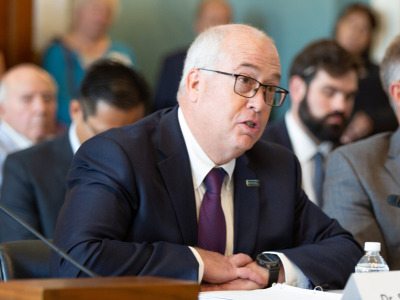The debate over the role of nonfat solids in the nation’s milk is back as organizations and government officials look for a way to put a little more money in the producer’s pocket.
The dialogue has popped back up from Capitol Hill to California, but familiar opposition could stand in the way of a fresh push for action.
In early 2018, the Congressional Dairy Farmer Caucus — led by representatives from Vermont, Connecticut, Minnesota, Wisconsin, and California — asked the University of Missouri’s Agricultural Markets and Policy (AMAP) to revive an issue that many in the industry thought long dead. The five caucus co-chairs asked AMAP to update an analysis conducted a decade earlier on the impact of adopting California fluid milk standards throughout the federal order system.
“Some members of Congress have interest in exploring the possibility,” says Scott Brown, of the Department of Agricultural and Applied Economics at the University of Missouri and lead economist on the updated AMAP study. “They were looking for any options that raised the milk price. They were seeing tremendous hurt in the Northeast and were asking whether this would help farmers in their region.”

Scott Brown, University of Missouri
A lot has changed since AMAP was asked to take a look. California dairy producers joined the federal order system in October 2018, the new farm bill became law in December 2018, farm milk prices have increased, and California Dairies rejoined the National Milk Producers Federation (NMPF) this past spring — all will impact the future direction of this issue.
How California — the nation’s top milk-producing state with more than 18 of the nation’s milk supply — ended up with different minimum milk standards than the rest of the country dates back several decades when the state’s industry was just starting to boom.
Peter Vitaliano, vice president of economic policy and market research at NMPF, says at that time, California had an excess of milk and basically no processing capacity. As a result, dairy co-ops were paying to truck milk out of state, sometimes over the Rockies, to be processed into cheese and butter — a costly endeavor. To help rectify the problem, the state passed legislation to encourage co-ops and others to build butter-powder and cheese plants, while adopting high compositional fluid milk standards as a means to use the resulting nonfat dry milk.
“Both were successful,” Vitaliano says.
California’s minimum compositional milk standards are higher than the U.S. Food and Drug Administration’s federal standards for nonfat solids, the part of milk that contains protein, lactose, and minerals. To achieve the higher minimum standards, bottlers in California use condensed skim milk to fortify fluid milk. This results in less solids being funneled into milk driers to produce nonfat dry milk for the domestic market and skim milk powder for the export market.
When the state’s standards were legislated, bottlers in California were given a “fortification allowance” to pay for the additional cost of securing and storing the condensed skim milk needed to fortify their products. According to an earlier paper by former University of California dairy economist L. J. “Bees” Butler, the fortification allowance raised the retail price of milk by 16 to 20 cents per gallon. Today, bottlers in California no longer receive a fortification allowance, which was eliminated when California joined the federal order system. However, they still have the added cost of fortification.
If the standards issue gains traction, instituting fortification allowances throughout the federal order system would be on the table. And while it’s unclear whether higher retail prices and a different taste sensation from higher milk standards would raise or lower consumer demand for milk, higher standards would increase producer milk prices. If California’s compositional milk standards were adopted throughout the federal order system, bottlers would use an additional 300 million pounds of nonfat solids a year, according to the AMAP analysis. This in turn would increase nonfat dry milk prices by an average of 18 cents per pound.
According to the AMAP study, higher nonfat dry milk prices would result in a 69-cent per hundredweight increase in farm-level milk prices the first year of the analysis, but the impact would steadily decline to a 13-cent per hundredweight increase by year 10. And because the 2018 farm bill changed Class I pricing from being based on the higher of Class III or IV prices to being based on an average of the two prices, Brown says adopting higher solids could help producers more often.
While no law prohibits bottling companies from adding solids nonfat to their milk voluntarily, there is a cost to do so, a cost that must be recouped from the marketplace for a bottler to stay competitive. Indiana-based Fairlife, a joint venture between Coca Cola and a group of dairy producers, is an example of a company that through ultra-filtration has increased the compositional standards of milk while removing lactose. Today, Fairlife milks are sold throughout the country — including in California — and are branded as premium milks.
Brown says for the issue to garner enough support to become a reality, more data would be needed to answer the question of whether consumers have a preference for higher-solids fluid milk. Currently, he says, there is no scientifically based work that consumers either do or do not prefer it. If they do, raising minimum standards could be a win-win for the industry if it were to retain milk drinkers and bring former milk drinkers back to the fold, Brown notes.
At the June NMPF board of directors’ meeting, CDI raised the issue of increasing federal milk standards and the NMPF board approved a motion that directed NMPF to engage with the International Dairy Foods Association (IDFA) to pursue common ground on the issue, according to representatives from both NMPF and CDI.

Matt Herrick, IDFA
At this point, though, it would take some convincing for processors to support the policy. “Our members represent the full spectrum of dairy companies ... and they have remained generally unsupportive of this proposed policy change,” says Matt Herrick, senior vice president of public affairs for IDFA. “Frankly, it’s an issue that requires more study to look closely at how proposed changes would impact farmers, food companies and consumers, alike.”
Rob Vandenheuvel, vice president of industry and member relations with CDI, admits that discussions are “in the very early stages. We are working with National Milk and industry organizations around the country to introduce the idea. Adopting California milk standards would result in raising the bar on the nutrient content in a glass of fluid milk regardless of butterfat content.”
However, legislators will want to see a proposal with minimal controversy. “In the past, the bottlers have been opposed,” Vandenheuvel says. “The conversations going on now are between National Milk and IDFA — that’s a first step. At this point, we don’t know if we can find common ground.” He doubts the issue will advance this year but says it could become an issue for the 2023 farm bill.
There is no law stopping bottlers from voluntarily adding solids nonfat to their milk or increasing the solids content through ultra-filtration, but there also is nothing stopping Californians from shopping for milk across state lines if the retail cost of their higher-solids milk increases to levels well above milk sold in neighboring states. That could become especially true now that California bottlers, who have lost their fortification allowance, have to pass more of the cost of fortifying milk on to the state’s consumers.
For more news, go to www.Agri-Pulse.com.

